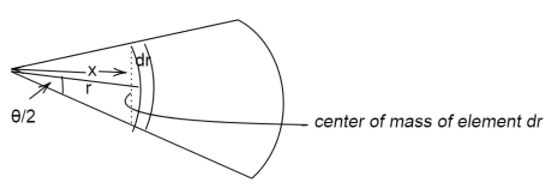Question
Question: The distance between the vertex and the centre of mass of a uniform solid planar circular segment of...
The distance between the vertex and the centre of mass of a uniform solid planar circular segment of angular size θ and radius R is given by:

A) 34Rθsin2θ
B) Rθsin2θ
C) 34Rcos(2θ)
D) 32Rcosθ
Solution
We will let the distance between the vertex and the center of mass be x and then with the small element dr and half of the angle as it divide the sector in two part where x lies, we will find out the equation to express the x and then integrate from 0 to R for the center of mass.
Complete step by step solution:
Let center of mass be lie at somewhere point C

And we need to find the distance of vertex and center of mass say OC
R is the radius in the figure. Let us take a small element dr
The mass of the sector is uniform.
Let σ (mass density) or mass per unit area
Mathematically to find the arc of the sector we have, arc = θ×r, where θ is the angle made by sector and r is the radius.
Then the area of the small element is rθdr and by multiplying it with density we will get its mass.
So, for the small arc element dr the mass will be dm = σrθdr here dm is the mass along dr.
Let the center of mass lie at point which is x distance far from the vertex.
Then x=2θrsin2θ , Now to get the center of mass we need to integrate x with the dm
⇒xcenter of mass =0∫Rdm0∫Rxdm and range will be from 0 to R
Now, putting the values
⇒xcenter of mass =0∫Rσ(rθ)dr0∫Rrsin2θ×σ(rθ)dr
Taking out the constant terms and cancelling out we will get,
⇒xcenter of mass =θ0∫Rrdr2sin2θ0∫Rr2dr
Taking the limits from 0 to R, this is now equal to after integrating is,
⇒θ2sin2θR×2R23R3
On further solving we can write it as 3θ4Rsin2θ.
So, xcenter of mass = 3θ4Rsin2θ(from vertex)
Hence option A is correct.
Additional information:
Center of mass: The center of mass is a position defined relative to an object or system of objects. It is the average position of all the parts of the system, weighted according to their masses. For simple rigid objects with uniform density, the center of mass is located at the centroid.
A circle is a 2D object as stated above but when we talk about the 3D object then a circle is known as a sphere and has a different formula for the area and volume
Area of sphere =4πr2
And volume of sphere =34πr3 where r is the radius
There are some important points regarding the circle which might be asked in different question
Sector of a circle
A circle can be divided into many parts as a sector as shown in fig.

Chord of a circle
A chord divides a circle in two parts. It may or may not divide in equal parts as shown in the diagram.

Note: There are many points where mistakes can happen; the only simple rule of integration needs to be remembering that in numerator function power plus one and denominator is power plus one. Taking out of the constant terms and cancelling out is important to be done cautiously.
